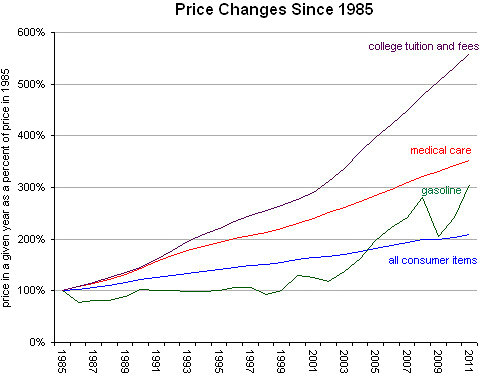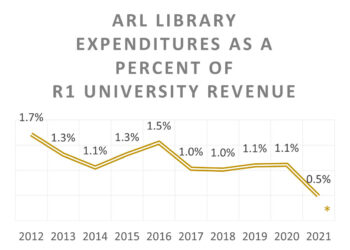
We keep hearing that the current system of scholarly publishing is fiscally “unsustainable.” This assertion is generally greeted with acceptance, as if we all agree both that this is the case and that we have a common understanding of what “unsustainable” means — up to and including the statement’s implications and its reflection on us, the people running the system today.
What is truly driving the impression of unsustainability? And why do we pass over this assertion with such ease?
Last year, a study showed that the fiscal challenges in scholarly publishing are mainly volume-based (more is being published) rather than price-based (per-title prices actually fell meaningfully between 2005 and 2010). More scientists are working, they are producing more papers, publication events are more highly valued in academic careers than ever, and publishers are responding by launching more titles. Paying for more subscriptions (or paying for APCs) costs libraries money, and they don’t have enough to spend for all the new titles and articles given trends in library funding as a percentage of university budgets.
Why this is the case bears some examination. Since the 1980s, library budgets have decreased as a share of university budgets by about half, from 3.7% in the early 1980s to under 2% now. However, library budgets have increased during the same time in dollar terms, primarily because the price of going to college has increased by 500% for an equivalent timeframe.
 The result is that, rather than being 500% larger, university library budgets are 250% larger, which just about covers the costs associated with all the new and expanded journals they have to buy. The key term here is, “just about.”
The result is that, rather than being 500% larger, university library budgets are 250% larger, which just about covers the costs associated with all the new and expanded journals they have to buy. The key term here is, “just about.”
The marginal deficit between what’s being produced and what’s affordable is what people generally mean when they use the term “unsustainable.” And, if current trends continue and nothing changes in response to these trends, the term is fairly accurate. Furthermore, if we change the wrong things in response, the situation could become worse.
One thing that has changed is that some libraries have diverted a portion of their budgets to open access (OA) funding, which takes more money out of the subscription pool without eliminating subscription costs or demand for the associated publications. The gamble here seems to be that if enough libraries support OA with small money, the tables may turn, and subscriptions will go away or shrink radically in price. This is not a wager I would make if I were in the position to do so, especially because the volume of published research is still increasing, and subscription journals are absorbing a good deal of this.
Subscriptions are more affordable generally because they spread costs across many more purchasers than OA models, which concentrate purchasers. Concentrated purchasing is less sustainable. One change over the past 15 years has been a greater concentration of subscription costs with libraries, as site licenses shifted many departmental and individual subscriptions into library budgets.
Concentrated buying tends to be more unsustainable, because if one purchaser leaves the market unexpectedly, prices for the other purchasers increase. In extreme cases, the remaining purchasers can see their costs skyrocket, or the providers can be left high and dry. In something akin to a monopsony, one large buyer could come to dominate any particular OA market, much as the state of Texas came to dominate the US textbook market due to its concentrated buying power. This was rectified in 2011, when Texas passed a law that took power away from the state board and split it among the state’s school districts. Suddenly, Texas lost much of its ability to demand editorial concessions from textbook publishers. Having more diversity in the customer base is good for editorial independence.
The “unsustainable” perception has many layers in the academic sphere, as much of what is going on in academia also seems unsustainable presently.
Tuition and fees. In the US, the trends around tuition and fees seems unsustainable. These have increased at an incredible pace over the past 30 years. Parents are already re-evaluating the benefits of university brand compared to university value. High tuitions balanced lackluster salaries for the majority of Americans have created a situation where food pantries are now emerging on college campuses. The higher education bubble seems closer to popping, or rapidly deflating, with each passing year.
Soft money trends. The lifestyle of the researcher may be unsustainable. I recently shared a flight with a researcher whose entire career consists of chasing soft money. He may complete the next 20-25 years of his career and never reach the end of the soft money train, but he may not. He, and thousands like him, are exhausted, fed up, and feeling scammed by a system that promised them rewards for their brilliance and dedication but instead set them on a Sisyphean quest for soft money rewards.
Librarians as purchasers. The “librarian as purchaser” is potentially an unsustainable position, especially if the small bets on OA mentioned above pay off, so to speak. Should OA ever come to dominate scholarly publishing, the role of the librarian — already perceived mainly as a purchasing agent for institutions — becomes all the more tenuous, and potentially unsustainable. Whether OA gains market dominance or not, the consolidation in the publishing world points to a future where far fewer contracts exist between institutions and publishers, another factor that could threaten this librarian role.
Government research budgets. Already, sequestration and other austerity measures have given research budgets in the US and Europe unflattering haircuts. If certain political ideas take hold, euphemisms like “accountability” and “practical research” may constrain pure research budgets even further. This trend also has some concerned that pure, basic research itself may be unsustainable, as universities become more like businesses and research becomes more about producing marketable products rather than fundamental insights.
Allow me to list a couple of other examples of “unsustained” items, to zero-in on what “unsustainable” might more accurately mean.
The middle-class in America. Shockingly, the American middle-class now appears to be unsustainable. This wasn’t the case until relatively recently, but the trends underlying this are 20-30 years old. Due to active dismantling through changes in taxation favoring elites, wage stagnation, public apathy, and other factors, the middle-class is clearly threatened and may be unsustainable unless things change.
Effective vaccine programs. Vaccination, one of the two major public health transformations in human history (the other being clean drinking water) is proving “unsustainable” in the face of public health diseducation by misguided semi-famous people and fear-mongering opportunists. Too many people, misled into thinking vaccines are something to fear, have been hiding out inside the herd effect, which is starting to lose its efficacy. Measles, once thought eradicated as recently as 2000, has cropped up again in New England and New York City, with more cases certain to follow.
The main point of all these examples is that nothing is sustainable if you neglect basic maintenance and funding. In the case of research publications, universities and others have accepted funding for conducting research while decreasing funding as a percentage of their budgets for subscriptions to published research. This is the fundamental breakdown in the economics of research publication. A system that increases supply while underfunding demand is predictably unsustainable.
Talking about the current system of academic publishing being “unsustainable” in the same way we talk about the weather being warm or the sky being blue — as if the situation is merely an observation and not something we have some control over or have had a hand in allowing come to pass — isn’t to me the right way to talk about it.
Maybe, instead of blithely stating that scholarly publishing is unsustainable, a more useful and addressable description of our current reality is that we may be working inside a system that we are failing to sustain.
Discussion
23 Thoughts on "What Does "Unsustainable" Mean?"
“Instead of blithely stating that scholarly publishing is unsustainable, a more useful and addressable description of our current reality is that we may be working inside a system that we are failing to sustain.”
Even that doesn’t get to the core of the matter. The real issue is whether we want to sustain the current system of scholarly publishing. Not many people would argue that the system we have now is anywhere close to optimal. The question for me is not how we can keep doing what we’ve always done, but what we need to do to make full use of the huge advantages that technological advances (mostly the Internet) offer us.
I wouldn’t assume that technology is more influential than culture, or that newer technologies are less expensive or more sustainable than prior technologies (i.e., print). Whatever cultural or technological norms dominate, the economics have to be in place for them to be sustained.
“I wouldn’t assume that technology is more influential than culture […]”
Oh, neither would I! Sorry if I gave that impression. No indeed — all technology can do is offer us possibilities. What we actually do with those possibilities (a range that goes all the way down to “nothing at all”) is totally dependent on culture.
Where we differ is that I lament this, whereas (I think) you consider it mostly a good thing. The Internet offers us possibilities far, far beyond a more efficient means of distributing what we were doing before. At the moment, that’s about as far as our culture has allowed us to go. We can and must do better.
“[…] or that newer technologies are less expensive or more sustainable than prior technologies.”
Let’s try always to be clear about when we’re talking about (A) the cost of getting a manuscript into “published” condition; and (B) the marginal cost of each additional copy of that published work. Technology is of some use in A, but clearly the bulk of that work has to be done by humans. Where technology really wins is in B: marginal cost is so close to zero that it can’t even be measured. Society can hardly be surprised if publishers see that as an opportunity to get free money; neither should publishers be surprised if society has other plans.
Actually, Mike, the role of technology in A is greater than you may appreciate. E.g., it used to be a laborious process to design book covers in the print only era, but computers like the Mac made it possible for designers to experiment with alternative designs at next to no cost. Copyediting became much more efficient with the ability of computers to do global searches to locate instances of a word throughout a manuscript, to highlight suggested changes in the text, to put queries in the margin, etc. Editorial tracking systems have helped with the efficiency of managing submissions and peer review. The list of such improvements in the process of publishing enabled by computers is a long one.
I don’t think that’s the “real issue” at all, Mike. The real issue is that many of the participants in the economy of scholarly communications do not understand how the economy works. That does not mean that they should or would like the economy if they understood it, but they would be more effective advocates for their own interests if they did understand it. Example: library consortia, created to push back against large publishers, have now been coopted by large publishers.
I guess we could go back and forth on which issue is most “real”. Instead, let’s just accept that both are genuine issues that should not be overlooked. Surely even you and I can agree to that extent? 🙂
Agreed. Most academics I know don’t want to “dirty their hands” with anything that remotely resembles commercial, corporate or capitalist. That includes the economics and business models of scholarly publishing
Your conjecture about the “fundamental breakdown in the economics of research publication” is certainly interesting but a key piece of data is missing, namely university research income over the period. Has external research funding really outpaced library funding all that much? On the other hand internal research funding from this huge tuition stream may also be a contributing factor, as universities fund a lot of research internally. What does the graph of research funding versus the publication buying budget look like?
But in any case the only things that seem unsustainable are that every journal prospers and every paper gets published.
Excellent article about the rise of cost of all aspects of living. Interesting to note that the cost for education the backbone of a society is showing a much greater rise is a matter of concern. It is commendable that http://www.ijsmet.com has shown a path to the academia that , “Cost can be kept under control by judicious thinking”. This is only a small part of the whole aspect of Education though.
One can put underperforming publications out of print and not reduce price and in fact increase price for those in demand. Regarding technology, publishing is labor intensive and the labor part for the most part has not been replaced by technology. Additionally, technology is expensive and costs really have not gone down because of it.
I’m not sure that Librarians would see many consequences were our role as purchasers were to go away. Many of us are doing the jobs of 3-4 people, as budget cuts make it impossible for us to hire in strategic areas (research data management, for example) and our administrators have to ask us to take on new duties.
Were our role as purchasers to end, I imagine many of us would be relieved that we could focus more on many of our other duties: supporting undergraduate teaching, learning and educating on software and technologies (Mendeley), etc.
As long as there are publishers producing goods and services and consumers willing to purchase them, then we have a market. What many complain about is that the market has been gradually changing from a producer-side market–where librarians purchased almost any scholarly product at almost any price–to a consumer-side market–where there is real competition among publishers for a limited consumer market. This is a difficult transformation, but one that is ultimately beneficial: Price increases (at least in the subscription market) look nothing like the 1980s and 1990s. Publishers cannot simply believe that a new product will make them money in the first year or two. I view “unsustainable” as a return to a healthier market, uncomfortable as it may be for those who have a fond memory of the past.
On one point, I’d add that the pursuit of the OA model is partially because it does create cash flow almost immediately for publishers, as APCs are faster to come than subscription dollars. That’s partly why some sketchy OA publishers enter the market — quick cash. The subscription model creates a higher barrier to entry.
As I read it, you believe the market is not “unsustainable” but merely self-correcting. If so, we should talk about a period of pricing correction, and not run around recklessly using terms like “crisis” and “unsustainable.” It’s not as exciting to state that we’re going through a period of low-volatility pricing in the subscription market, but it seems much more accurate.
Coincidentally, one of my first Scholarly Kitchen posts in June 2008 was about the term “crisis” as in “crisis in scholarly communication” (see: http://scholarlykitchen.sspnet.org/2008/06/03/crisis-what-crisis/)
I think those who use this term (and similarly, “unsustainable”) use it strategically because it implies a perpetrator (greedy publishers), a victim (librarians and their scholars), and allows one to make a call of collection action (support open access). Reality is much more nuanced and complex, but lacks this clear narrative.
As I understand Kent’s article (which is less than easy because it is like following a country road, what with the measles and all) the basic point is that the research budget is growing faster than the research publication purchasing budget. It is far from clear how restructuring the publication system will fix this problem. Restructuring is expensive, which may be part of the problem, not its solution.
Kent, you talk about libraries as purchasers but not libraries as publishers. Increasingly, libraries are taking on that role, in a variety of ways, and even setting up presses to do OA monograph publishing, as at Amherst, or textbook publishing, as at SUNY-Geneseo. This is not just a marginal activity anymore, as the formation of the Library Publishing Coalition with over 50 members shows.
Under “tuition and fees” you might note that what really matters is the net cost, not the announced tuition, since almost all colleges offer discounts on that full price in a variety of ways. E.g., over 60% of the students who attend Princeton get financial aid, and it is all in the form of grants, not loans, so students are able to graduate debt-free, if they wish.
As for the plight of the middle class, the most important factor undermining its sustainability is income volatility and economic insecurity, as discussed by Jacob Hacker in his 2007 book “The Great Risk Shift” (Oxford).
Kent – great post. Those that use the term “unsustainable” with regard to library budgets are often, from my experience, looking at journal purchasing from the lens of the library itself. In other words, they are seeing their budgets shrinking and saying “this is not sustainable.” The library budget, however, is a decision that is made, on a year-to-year basis, by university administration. They could just as easily choose to build a less lavish rec center, spend less on groundskeeping, put off refurbishing the alumni club, or whatever. The point is, the library budget is not a thing unto itself, it is a very small part of an institution’s budget. That it has not kept up, in many cases, with the increase in volume of publications or with other line items in budget (or, to use a rough proxy for overall higher education costs, with tuition) is not some natural process (like having less rain water in the reservoir), it is a choice made by university administrators.
This reminds me of one of my favorite questions to ask university deans and administrators: “Who gets more attention during budget time? Librarians or groundskeepers?”
So far, groundskeepers are running the table.
If memory serves the library is the middle man and the faculty determine what is purchased. The library then has to see what is in the budget and tell the faculty. The faculty then has to fight for money for its pet journal – that is if the journal is to be dropped for budgetary reasons.
Regarding sustainability. It seems that if a journal is losing market or never had one that it is no longer published. The house cuts its loses. In the case of a society where the journal is an integral part of the offerings to membership, the society has a choice raise dues, go into a partnership with a commercial publisher or accept the loss.
However, it does not appear that the journal publishing business is unsustainable. OA is now a profit center for most STEM houses.
Not at my university. We lost 40% of our state funds over a couple of years. The units that took the biggest cuts were the non-academic areas. We used to have beautiful grounds and now the place is largely barren. They spiff it up a bit at graduation, but nowhere near what they used to do. Meanwhile the overall library budget remained fairly close to stable. The difference is who is paying as we now have a reasonably large library student fee along side near doubling of tuition over the last decade.
As for your use of the chart showing a steady decrease in the library’s portion of university budgets, note the dates covered and the role of information technology at universities over that time span.
Addressing just the first part of this article (upon which the rest seems to be based), university budgets have exploded over this time period because of massive fundraising and capital investments, rising tuition, enrollment, sports revenues, and many other factors. Library budgets as a percentage of this total have decreased, but this is a specious statistic, especially given the technological changes over this period. This chart puts it into clearer perspective, adding a second trend line showing the budget growth versus library decline: http://www.libqual.org/documents/admin/EG_3.pdf. And click here to view a chart from the very same ARL report cited by the author showing the explosion in library expenses over this time period: http//arl.nonprofitsoapbox.com/storage/documents/expenditure-trends.pdf
Thanks for the chart combining the two I show. I was going to include one like it, but the post was getting rather long.
As for the other link, it doesn’t work, but Google likes this is an alternative: http://www.arl.org/storage/documents/expenditure-trends.pdf. Like other charts focusing purely on expenditures, this fails to document whether the changes are the result of higher volumes of published research, higher costs, or both. Other charts I link to show that it’s primarily a volume-based explosion in supply.
The decrease in library budgets as a percentage of overall budgets is not “specious” but is rather very meaningful. Also, technological change has no implicit price guarantee. That said, per-serial costs have gone down over the past 8-9 years, underscoring that the budget pressures libraries are feeling come from the fact that more researchers are publishing more research.



